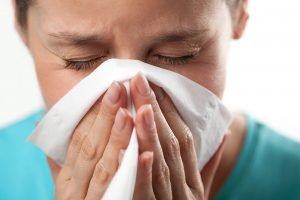Summary
Sinusitis is a condition characterized by infection and inflammation of the sinuses, which are small air-filled cavities located between the nose and the eyes. When these cavities become blocked, mucus can accumulate, providing a breeding ground for germs. This can lead to symptoms such as a blocked nose, post-nasal drip (mucus flowing down the throat), facial pain, headaches, sore throat, cough, and bad breath.
The most common causes of sinusitis include microbial infections, such as viruses and bacteria. Sinusitis often develops following a cold, allergies, nasal polyps, or a deviated septum. The infection can typically be managed with home remedies, especially if the symptoms are mild. In more severe cases, doctors may prescribe treatments to alleviate symptoms, including decongestants, nasal sprays, and pain relievers. Depending on the underlying cause, antibiotics, anti-allergy injections, or antifungal medications may be necessary. If medication fails to relieve symptoms, surgery may be considered as a last resort.
Table of Contents
Symptoms of Sinusitis

The symptoms of sinusitis can vary depending on the cause and severity of the condition. Common symptoms experienced by patients include:
- Nasal congestion. A blocked nose due to inflammation can make it difficult to breathe through the nostrils.
- Swelling inside the nose. Inflammation of the nasal passages can cause swelling, further contributing to congestion and discomfort.
- Post-nasal drip. Mucus may drain down the back of the throat, causing irritation and the sensation of mucus constantly flowing into the throat.
- Facial pain. Pain or pressure is commonly felt in areas around the eyes, nose, cheeks, or forehead due to the inflammation of the sinuses.
- Headache. Sinus pressure can lead to headaches, especially around the forehead, eyes, or the back of the head.
- Sore throat. The irritation caused by post-nasal drip may result in a scratchy or sore throat.
- Persistent cough. The constant drainage of mucus can trigger a cough, which may worsen at night or upon lying down.
- Bad breath. The buildup of mucus and bacteria in the sinuses can lead to halitosis, or bad breath.
- Difficulty breathing. Severe congestion can make breathing difficult, particularly through the nose.
- Reduced sense of smell and taste. Inflammation can affect the ability to smell and taste things as usual.
- Ear pain. Sinus pressure may extend to the ears, causing discomfort or a feeling of fullness.
- Pain in the upper jaw and teeth. Sinus pressure can affect the upper teeth and jaw, causing discomfort similar to a toothache.
- Fatigue. Persistent symptoms can lead to a feeling of tiredness or general weakness.
These symptoms indicate the presence of sinus inflammation and may require treatment to alleviate discomfort and prevent further complications.
Types of Sinusitis
Sinusitis is classified into two main types based on the duration and cause of the condition:
- Acute sinusitis. This type of sinusitis is typically caused by viruses associated with the common cold or seasonal allergies. Acute sinusitis usually lasts up to 2 weeks, with symptoms such as nasal congestion, facial pain, and post-nasal drip resolving as the underlying viral infection or allergy subsides.
- Chronic sinusitis. Chronic sinusitis may be caused by a bacterial infection or structural nasal issues such as nasal polyps or a deviated septum. The symptoms of chronic sinusitis persist for 3 months or longer, and the condition may involve more severe or recurring symptoms. In some cases, underlying conditions such as fungal infections or immune system disorders can also contribute to chronic sinusitis.
Understanding the differences between these two types is important for determining the appropriate treatment approach, as the causes and duration of symptoms vary.
Diagnostic Procedures for Sinusitis
Diagnosing sinusitis involves a combination of medical history, physical examination, and, in some cases, imaging tests or laboratory analyses. The main diagnostic procedures include:
- Medical history and physical examination. The healthcare provider will ask about the patient’s symptoms, duration, and any potential triggers, such as recent colds or allergies. A physical examination may include feeling for tenderness around the nose and face and examining the inside of the nose with a lighted instrument to look for signs of inflammation or nasal discharge.
- Nasal endoscopy. A nasal endoscope—a thin, flexible tube with a light and camera—may be used to inspect the nasal passages and sinuses more closely. This procedure allows the doctor to look for signs of infection, nasal polyps, or other structural abnormalities.
- Imaging tests. If the diagnosis is unclear or if symptoms are persistent, imaging tests such as a CT scan or MRI may be recommended. These tests provide detailed images of the sinuses, helping to identify blockages, inflammation, or anatomical issues such as a deviated septum.
- Allergy testing. Since allergies can trigger or exacerbate sinusitis, allergy tests (such as skin prick tests or blood tests) may be performed to identify specific allergens that contribute to the condition.
- Sinus culture. In cases where bacterial infection is suspected, a sample of mucus may be taken from the nasal passages to determine the type of bacteria present. This can help guide appropriate antibiotic treatment.
- Blood tests. Although not commonly required for diagnosing sinusitis, blood tests may be used to check for underlying conditions that could weaken the immune system, making sinus infections more likely.
These diagnostic procedures help identify the cause of sinusitis and guide the development of an effective treatment plan.
Complications of Untreated Sinusitis
If sinusitis is left untreated or inadequately managed, it can lead to several complications that may significantly affect a person’s health. The potential complications of untreated sinusitis include:
- Chronic sinusitis. Acute sinusitis that is not treated effectively can develop into chronic sinusitis, where symptoms persist for 12 weeks or longer. This condition can be more difficult to treat and may require prolonged medical intervention.
- Sinus infections spreading to nearby areas. In rare cases, untreated sinus infections can spread to surrounding structures, such as the bones (osteomyelitis) or the tissues around the eye (orbital cellulitis), causing severe complications that may require emergency treatment.
- Meningitis. If the sinus infection spreads to the membranes surrounding the brain and spinal cord, it can lead to meningitis. This potentially life-threatening condition causes inflammation of the protective membranes and requires immediate medical attention.
- Abscess formation. In severe cases, untreated sinusitis can lead to the formation of an abscess (a pocket of pus) within the sinuses or other facial areas. This may cause intense pain, swelling, and, in some instances, neurological symptoms if the abscess affects the brain.
- Loss of smell and taste. Persistent inflammation in the sinuses can damage the olfactory nerves, leading to a partial or complete loss of the sense of smell. This may also affect the ability to taste food properly.
- Asthma flare-ups. Sinusitis can exacerbate asthma symptoms in individuals with both conditions, leading to increased difficulty breathing, wheezing, and a higher frequency of asthma attacks.
- Ear infections. The inflammation and congestion associated with sinusitis can block the eustachian tubes, leading to fluid buildup in the middle ear and resulting in ear infections.
Proper diagnosis and timely treatment of sinusitis are essential to prevent these complications and ensure a better quality of life.
Causes of Sinusitis

The primary causes of sinus infections are microbial agents such as viruses, bacteria, and, in some cases, fungi. These microorganisms can infect the sinuses under certain conditions, which include:
- Common cold. Viral infections such as the common cold can cause inflammation and congestion in the nasal passages, leading to sinus blockage and an increased risk of sinusitis.
- Allergies. Allergic reactions, such as hay fever, can cause swelling in the nasal passages, obstructing the sinuses and making them more susceptible to infection.
- Nasal polyps. These are small, noncancerous growths on the lining of the nasal passages or sinuses that can block airflow and drainage, creating a favorable environment for microbial growth.
- Deviated septum. This condition occurs when the bone and cartilage that divide the nasal cavity are off-center or crooked, which can obstruct the sinuses and contribute to recurrent infections.
These factors create conditions that allow viruses, bacteria, or fungi to enter and infect the sinuses, leading to inflammation and the symptoms associated with sinusitis.
Prevention of Sinusitis

To reduce the risk of developing a sinus infection, the following preventive measures are recommended:
- Practice regular handwashing. Washing your hands frequently helps remove germs that could be transferred to the face and nose, potentially causing infection.
- Avoid contact with people who have colds or the flu. Staying away from individuals with respiratory infections can reduce the risk of catching a virus that could lead to sinusitis.
- Quit smoking and avoid secondhand smoke. Smoking irritates the nasal passages and weakens the immune system, increasing the likelihood of sinus infections. If you do not smoke, avoid exposure to secondhand smoke.
- Use a humidifier. Keeping the air in your living space cool and slightly humid with a humidifier can help maintain moisture in the nasal passages, making breathing easier and preventing irritation.
- Get a yearly flu vaccine. Annual flu vaccinations help strengthen the immune system against influenza, reducing the chances of developing secondary sinus infections.
- Eat a healthy diet. Consuming nutritious foods such as fruits, vegetables, fish, and lean meats supports a strong immune system, making you less susceptible to infections.
- Avoid allergens. Minimize exposure to allergens that can trigger allergic reactions and lead to sinus inflammation, such as dust, pollen, and pet dander.
Implementing these preventive strategies can help reduce the risk of sinusitis and maintain overall respiratory health.
Risk Factors for Sinusitis
While anyone can develop a sinus infection or sinusitis, certain factors increase the likelihood of experiencing the condition. Individuals at higher risk include:
- People who frequently catch colds. Recurrent upper respiratory infections, such as colds, can lead to sinus inflammation and an increased risk of sinusitis.
- Individuals with seasonal allergies. Those who suffer from allergies, such as hay fever, are more likely to experience sinus inflammation due to their heightened sensitivity to allergens like pollen, dust, or mold.
- Smokers and those exposed to secondhand smoke. Smoking and exposure to secondhand smoke can irritate the nasal passages and weaken the body’s defenses, making sinus infections more likely.
- People with structural nasal problems. Conditions such as nasal polyps or a deviated septum can obstruct the nasal passages, preventing proper sinus drainage and increasing the risk of infection.
- Individuals with weakened immune systems. Those with compromised immunity, due to conditions such as diabetes, chemotherapy, or medications that suppress the immune system, are at greater risk of developing sinusitis.
- People with underlying health conditions. Conditions like HIV/AIDS or cystic fibrosis can impair the body’s ability to fight infections, increasing the likelihood of sinusitis.
Understanding these risk factors can help in taking preventive measures to reduce the chances of developing sinusitis.
Sinusitis FAQs
- What is sinusitis?
Sinusitis is an inflammation or infection of the sinuses, which are air-filled cavities located behind the forehead, nose, and cheeks. It can cause symptoms such as nasal congestion, facial pain, headache, and post-nasal drip. - What causes sinusitis?
Sinusitis is commonly caused by viruses, bacteria, or fungi. It can develop following a cold, allergies, or conditions that obstruct the sinuses, such as nasal polyps or a deviated septum. - What are the symptoms of sinusitis?
Common symptoms include a blocked nose, facial pain or pressure, thick nasal discharge, headache, sore throat, cough, and fatigue. Severe cases may also result in fever or tooth pain. - How is sinusitis diagnosed?
Diagnosis is usually based on a medical history and physical examination. In some cases, a nasal endoscopy, imaging tests, or sinus culture may be required for a more accurate diagnosis. - Can sinusitis be treated at home?
Mild cases of sinusitis can often be managed with home remedies such as using a humidifier, staying hydrated, applying warm compresses to the face, and taking over-the-counter decongestants. However, if symptoms persist or worsen, medical treatment may be necessary. - When should I see a doctor for sinusitis?
You should see a doctor if sinusitis symptoms last for more than 10 days, worsen after an initial improvement, or are accompanied by severe headaches, vision problems, or high fever. - What treatments are available for sinusitis?
Treatment may include decongestants, nasal sprays, pain relievers, and, in some cases, antibiotics if a bacterial infection is present. For chronic sinusitis, corticosteroids, antifungal medications, or even surgery may be recommended. - Can allergies cause sinusitis?
Yes, allergies can trigger sinus inflammation, leading to allergic sinusitis. Managing allergies effectively can help reduce the risk of developing sinusitis. - Is sinusitis contagious?
The sinusitis itself is not contagious, but the underlying viral infection (such as the common cold) that may cause sinusitis can be contagious. - How can I prevent sinusitis?
Preventive measures include practicing good hand hygiene, avoiding contact with people who have colds, using a humidifier, avoiding allergens, and getting an annual flu vaccine.


